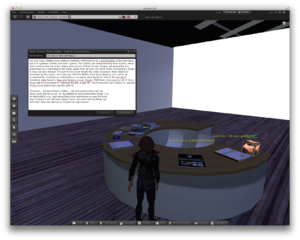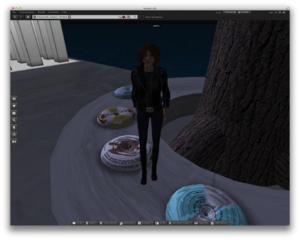User:Jules/Documentationpreservation: Difference between revisions
No edit summary |
No edit summary |
||
| Line 51: | Line 51: | ||
Video and photographic documentation of the artists' re-enactments of some of the most famous performances from the 70's (from Chris Burden, Joseph Beuys, Gilbert&Georges etc). The performances took place in the Second Life space owned by Odyssey Contemporary Art and Performance Simulator. The artists got the performances programmed in advance and ran it at precise times inside the virtual space. The documentation has the same role as for offline performances. For instance, we all know about Shoot for Chris Burden. Although we were not at F Space Gallery in Los Angeles on the 19th of November 1971 at 7:45 pm. It is acknowledged that performances can only enter the art world through their mediatization and that the documentation can be exhibited into galleries. The documentation “for preservation” is following the same traditional method.<br> | Video and photographic documentation of the artists' re-enactments of some of the most famous performances from the 70's (from Chris Burden, Joseph Beuys, Gilbert&Georges etc). The performances took place in the Second Life space owned by Odyssey Contemporary Art and Performance Simulator. The artists got the performances programmed in advance and ran it at precise times inside the virtual space. The documentation has the same role as for offline performances. For instance, we all know about Shoot for Chris Burden. Although we were not at F Space Gallery in Los Angeles on the 19th of November 1971 at 7:45 pm. It is acknowledged that performances can only enter the art world through their mediatization and that the documentation can be exhibited into galleries. The documentation “for preservation” is following the same traditional method.<br> | ||
Slurl to Odyssey, which also contains a bit of documentation about the works: http://slurl.com/secondlife/Odyssey/122/45/25/<br> | Slurl to Odyssey, which also contains a bit of documentation about the works: http://slurl.com/secondlife/Odyssey/122/45/25/<br> | ||
<br> | <br> | ||
'''''ii. One terabyte of kilobyte age, Olia Lialina and Dragan Espenschied, 2010'''''<br> | '''''ii. One terabyte of kilobyte age, Olia Lialina and Dragan Espenschied, 2010'''''<br> | ||
Latest revision as of 00:32, 21 November 2014
I tried to "orientate" my examples towards the preservation of online practices as it is the subject I have more at heart. I tried to organize my findings into three categories:
A. Updating
Migrating the original work to make it fit within the modern infrastructure.
i. Bot TV 1.0 then 2.0, Marc Lee, 2004 - 2010
http://www.digitalartconservation.org/index.php/en/exhibitions/zkm-exhibition/nnnnnmarc-lee.html
The digital art conservation project was initiated by the ZKM | Center for Art and Media Karlsruhe and lasted from 2010 to 2012. The website documents a few case studies which are worth having a look at. The Bot TV example is interesting. Bot TV is an Internet News channel broadcasting news less than one hour old through an automated process. The first version was made in 2004, relying on Real Player application. In 2010, the piece wasn't functional anymore due to the evolution of the web standards, which had made a shift towards Flash Player. The artist decided to adapt his work to Flash player and "modernize it". He added the 2.0 to the title to mark the transition.
Now in 2014 it seems like this is a matter of time before the Bot TV 2.0 will be confronted with the same problems as its predecessor. Flash player already sounds fairly obsolete since the video and audio current standards have shifted towards HTML5 since its introduction.
You can (still) see the Bot TV 2.0 here >>>> http://www.1go1.net/56ktv/index.html
The first version is meant to be only accessible through a video documentation from 2005, but I haven't found it.
ii. Agatha Appears, Olia Lialina, 1997 - restauration in 2008
http://www.incca.org/resources/106-preservation/390-wysocka-e-agatha-re-appears-net-art-resoration-project
Probably the most famous example of a first generation net art website's conservation.
The original work was made using HTML 3.2 language, adapted for Netscape 4.0 web browser and using real audio sound format. In 2008 the piece had become incompatible with the new web browsers, as the standards had evolved. Therefore the whole piece was not interactive anymore. Some files had also disappeared and therefore the aim of the original work was not "there" anymore. Elżbieta Wysocka decided to re-establish compatibility with modern browsers, in some way to mimic the original behaviour using modern standards. Although it is realistically stated that this is just a time limited extension of the life span of the piece due to the unstable aspect of the infrastructure (The outcome of the project concludes this way: "Since the problem will continue to grow we may assume that soon there will be no easy and unquestionable solutions…").
B. Emulating
Documenting of the pieces through the building of specific old-like infrastructures to support them(mimicking the old environment e.g browsers).
i. bwFLA ― Emulation as a Service
http://bw-fla.uni-freiburg.de/demos.html
A project initiated by researchers from the University of Freiburg. The aim is to recreate the interaction with digital content inside its context of origin. They recreated the old infrastructure inside modern contexts, enabling the visioning of the outdated files. The idea is to make this service available through modern web browsers. This means the emulating software will also require updating.
ii. Colloq, Rhizome, In making
http://bits.blogs.nytimes.com/2014/10/19/a-new-tool-to-preserve-moments-on-the-internet/?_php=true&_type=blogs&_r=1
Colloq is initiated by Rhizome and was made official about a month ago. The aim is to create a tool for social media archiving to “preserve that kind of complex, immersive experience”. The software has been developed with the help of a programmer who has worked on the Internet Archive's Wayback Machine (Ilya Kreymer) and the code is available on Github (an online repository for the version control software called Git).
Also to be mentioned that Dragan Espeschied became head of the Digital Art Conservation at Rhizome before this project was started. He has also been involved with the bwFLa project cited above. This is a small world.
The prototype can be found at this address : http://webenact.rhizome.org/excellences-and-perfections/
The code is here : https://github.com/ikreymer/pywb
iii. Once Upon, Olia Lialina and Dragan Espenschied, 2011
http://1x-upon.com/
“Three important contemporary web sites, recreated with technology and spirit of late 1997, according to our memories.”
Does what it says on the tin. The websites are Google +, YouTube and Facebook. And it works well, the interfaces aesthetics really gives a feeling of pre 21st century website. The server's transfer speed has also been reduced to 8 kilobits per second which makes the experience even more “real” through the re-creation of slow loading pages.
This is not really a work of preservation but perhaps a contemporary artefact that fits old infrastructures rather than the ones of its time. It was somehow guided by a certain nostalgia of a passed Internet era, which can be related to the pre-cited methods (trying to preserve the User experience and the “feel” of the work).
C. Re-materializing into more stable media objects
No maintaining of the work alive “as it was” but rather creating more stable documents to testify of its past existence.
i. Eva and Franco Mattes, Re-enactments, 2007-2010
http://0100101110101101.org/reenactments/
Video and photographic documentation of the artists' re-enactments of some of the most famous performances from the 70's (from Chris Burden, Joseph Beuys, Gilbert&Georges etc). The performances took place in the Second Life space owned by Odyssey Contemporary Art and Performance Simulator. The artists got the performances programmed in advance and ran it at precise times inside the virtual space. The documentation has the same role as for offline performances. For instance, we all know about Shoot for Chris Burden. Although we were not at F Space Gallery in Los Angeles on the 19th of November 1971 at 7:45 pm. It is acknowledged that performances can only enter the art world through their mediatization and that the documentation can be exhibited into galleries. The documentation “for preservation” is following the same traditional method.
Slurl to Odyssey, which also contains a bit of documentation about the works: http://slurl.com/secondlife/Odyssey/122/45/25/
ii. One terabyte of kilobyte age, Olia Lialina and Dragan Espenschied, 2010
http://oneterabyteofkilobyteage.tumblr.com/
This project is a showcase of the Geocities homepages archive. In 2010, one year after Yahoo! Shot down Geocities, Olia and Dragan started downloading a one Terabyte torrent of the pages as they were rescued by the “Archive team”. The download took more 5 months to be completed. The blog is filled with automatically generated screenshots displayed in chronological order. The screenshots restitute a fairly good idea of the web pages, as they also display the Operating Systems GUI and the Browser used for the navigation. This enables a certain 'datation' of the context from the recognition of the visual elements (at least for the people who were familiar with the pre Windows XP operating systems from Microsoft).
Olia has recently started to create little vine posts of the Geocities pages, and they have made me very happy:
https://vine.co/tags/geocities
Searching for the different ways of “documenting for preservation” of online art, was very thought provoking. It appears that the medium is performative by essence. Strategies that attempt to freeze the works appear like nostalgic attempts to postpone the works' decay. It is great to see the deployment of all those methods to preserve online works, as they show a lot of creativity in the approaches and provide us with varied points of views of online Art's characteristics.
But the race against the works technological decay seems to be in vain. It seems like the re-materialization is more sustainable on a long term basis. Perhaps instead of treating those works like “stable objects”, they should be treated like “performances”Or as performative objects.


